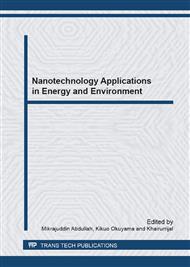[1]
C. Cameselle, M. Pazos, M.A. Sanromán, Selection of an electrolyte to enhance the electrochemical decolourisation of indigo. Optimisation and scale-up, Chemosphere. 60 (2005) 1080-1086.
DOI: 10.1016/j.chemosphere.2005.01.018
Google Scholar
[2]
C. Jo, J.H. Son, H.J. Lee, M.W. Byun, Irradiation application for color removal and purification of green tea leaves extract, Radiat. Phys. Chem. 66 (2003) 179-184.
DOI: 10.1016/s0969-806x(02)00273-6
Google Scholar
[3]
B.J. An, J.H. Kwak, J.H. Son, J.M. Park, J.Y. Lee, C. Jo, M.W. Byun, Biological and anti-microbial activity of irradiated green tea polyphenols, Food Chem. 88 (2004) 549-555.
DOI: 10.1016/j.foodchem.2004.01.070
Google Scholar
[4]
M.A. Sanromán, M. Pazos, M.T. Ricart, C. Cameselle, Electrochemical decolourisation of structurally different dyes, Chemosphere. 57 (2004) 233-239.
DOI: 10.1016/j.chemosphere.2004.06.019
Google Scholar
[5]
M. Panizza, G. Cerisola, Olive mill wastewater treatment by anodic oxidation with parallel plate electrodes. Water Res. 40 (2006) 1179-1184.
DOI: 10.1016/j.watres.2006.01.020
Google Scholar
[6]
C. Fierro, C. Comninellis, Kinetic study of formic acid oxidation on Ti/IrO2 electrodes prepared using the spin coating deposition technique, Electrochim. Acta. 55 (2010) 7067-7073.
DOI: 10.1016/j.electacta.2010.06.066
Google Scholar
[7]
T.N. Wu, Electrochemical removal of MTBE from water using the iridium dioxide coated electrode, Sep. Purif. Technol. 79 (2011) 216-220.
DOI: 10.1016/j.seppur.2011.02.008
Google Scholar
[8]
Y. Deng, J.D. Englehardt, Electrochemical oxidation for landfill leachate treatment, Waste Manage. 27 (2007) 380-388.
DOI: 10.1016/j.wasman.2006.02.004
Google Scholar
[9]
N. Mohan, N. Balasubramanian, C.A. Basha, Electrochemical oxidation of textile wastewater and its reuse, J. Hazard. Mater. 147 (2007) 644-651.
DOI: 10.1016/j.jhazmat.2007.01.063
Google Scholar
[10]
J.H. Chang, T.J. Yang, C.H. Tung, Performance of nano- and nonnano-catalytic electrodes for decontaminating municipal wastewater, J. Hazard. Mater. 163 (2009) 152-157.
DOI: 10.1016/j.jhazmat.2008.06.072
Google Scholar
[11]
C.R. Costa, P. Olivi, Effect of chloride concentration on the electrochemical treatment of a synthetic tannery wastewater, Electrochim. Acta. 54 (2009) 2046-2052.
DOI: 10.1016/j.electacta.2008.08.033
Google Scholar


